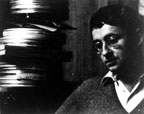Howls for Sade
Hurlements en faveur de Sade- FRANCE / 1952 / French / B&W / Video (Original: 35mm) / 75 min


Director, Script: Guy Debord
Voices: Gil J. Wolman, Guy Debord, Serge Berna, Barbara Rosenthal, Jean-Isidore Isou
International Distribution: Love Streams Production agnès b.
Source: Carlotta Films
Howls for Sade is Debord’s first film. Fascinated by the experimental nature of letterism, he definitely took on its avant-garde stance in this film. Isidore Isou, Gil J. Wolman and other letterists provided the voice-over. The film script, comprised of the “soundtrack” and the “images,” was first published in the letterist magazine Ion in April 1952. However, the “image” portion of this first script was never produced, resulting in a film without any “images”—a film made entirely of black and white images with a completely revised narration. The silent black sequences without any music or sound effects alternate with the blank white sections in which the five different voices narrate diverse and heterogeneous texts: certain passages from Isou and James Joyce, newspaper articles, and excerpts from civil law. The film premiered at the Ciné-Club d’Avant-Garde in June 1952. Shortly after the presentation began, a dispute arose between the audience and the club’s organizers, leading to its cancellation.
 Guy Debord (1931–94)
Guy Debord (1931–94)Born in Paris in 1931, Debord lived in the south of France until high school. At 19, after being strongly impacted by the Isidore Isou film Venom and Eternity (1951), which screened at Cannes, he participated in the letterist movement in Paris. Under the influence of letterism, which rebelled against surrealism’s stagnation and its incorporation into the system and rejected the existing frames of literature and art, he released his first film Howls for Sade in 1952, aiming to dismantle image and sound, down to the elements of composition. Gradually distancing himself from the letterist left-wing, with their increasing tendency to mysticism, Debord formed the Letterist International (LI) with Gil J. Wolman. Subsequently, in 1957 he joined with others, including Asger Jorn, a founder of CoBrA (a Scandinavian avant-garde art movement aimed at developing unconscious, free expression), to form the Situationist International (SI), which ultimately dissolved in 1972. Thoroughly critical of what he termed “spectacle,” or mass consumption in capitalist society, Debord’s attempts to create a political reality throughout all segments of society, to construct a “situation” at the extremes of the “spectacle,” were theoretically realized in his book The Society of the Spectacle (1967), which can be said to have predicted the revolution of May ’68. His activities were not limited to writing and filmmaking, however, and included a range of border-crossing artistic expression, including collections of images and text drawn solely from “détourned” advertisements, maps, novels, comics, and the like, and the collaborative invention of a war game with Alice Becker-Ho. In 1984, in protest at being questioned about the assassination of the financier of his films, Gérard Lebovici, Debord banned his films from being screened, and retreated to the tiny mountain village of Champot in Auvergne. Suffering a form of polyneuritis brought on by alcohol and refusing all treatment, Debord took his own life at his home in 1994. |
